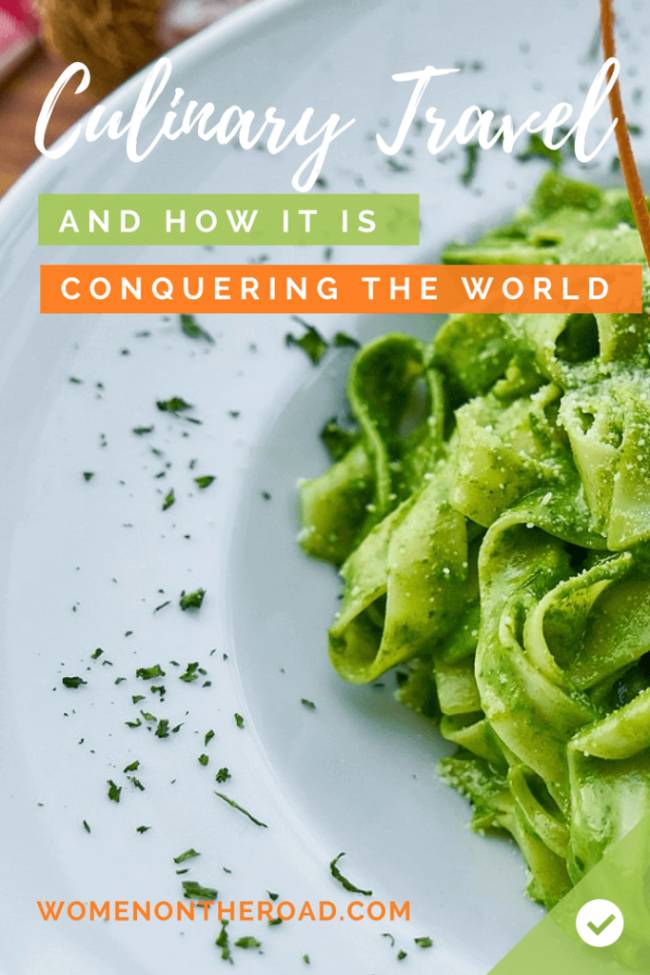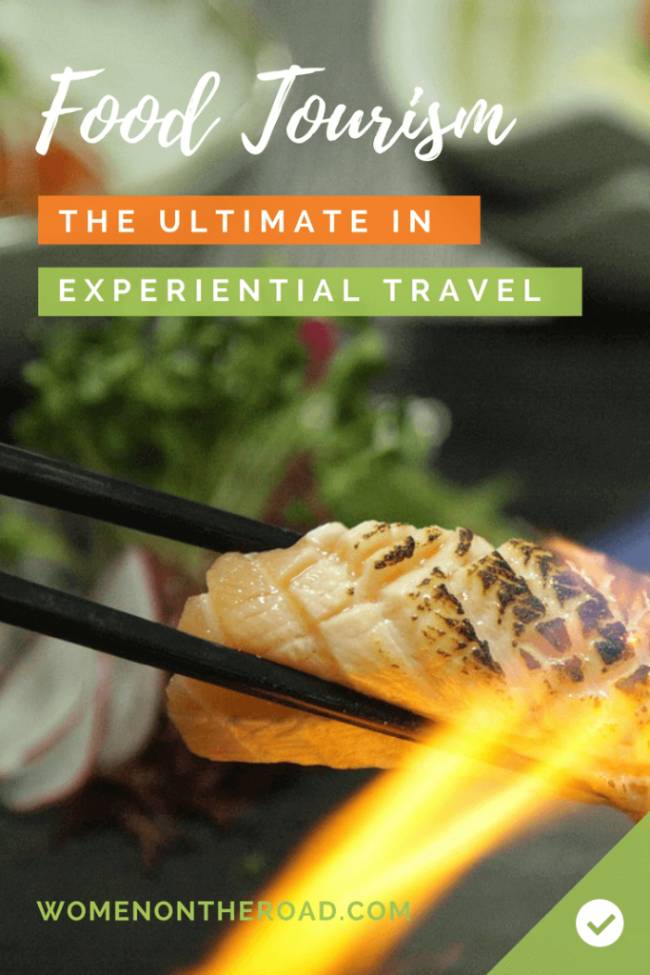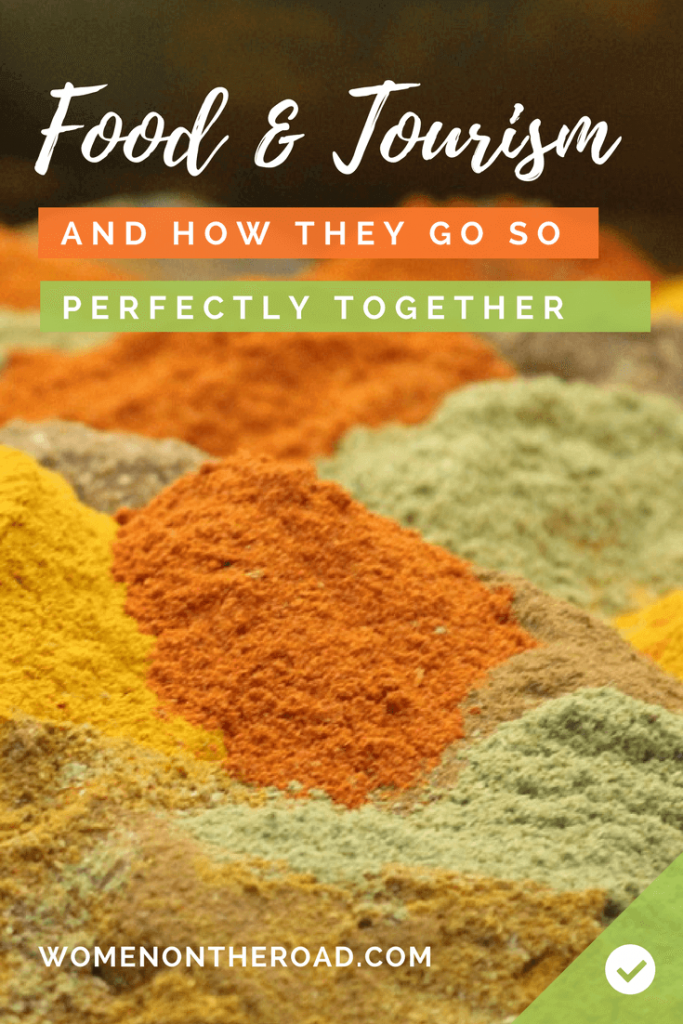Do you ever find that the smell of local foods is one of your strongest travel memories?
When I think of South Africa I smell grilled BBQ, with Naples I smell pizza crust and in France freshly-baked croissants from the boulangerie down the street.
Bangkok? Durian, I’m afraid… but also the bubbling curries of street stalls.
I find that food is one of the best ways to experience a culture, and food tourism, which is also called gastronomic tourism, culinary tourism or travel and even foodie tourism, is a growing travel trend – and even passion.

FOOD TOURISM AROUND THE WORLD: HOW TO COMBINE FOOD AND TRAVEL
When I’m planning a trip (most of my trips are food-related to some extent) here’s how I make sure I have the most delectable experience possible:
- Buy a few cookbooks and try cooking a few dishes to get a feel for the ingredients (fun, necessary, but not always successful — see photo below).
- Closely related to the above point, plan to learn to cook and look into cooking trips. I’ve taken a cooking class in Tuscany and in Bangkok and loved every minute. You’ll find private and group classes, lasting from several hours to several weeks, in proper culinary institutes or in hotels, restaurants and even in people’s homes. And a paella and tapas cooking class in Madrid, anyone? Just make sure you ask these 16 questions before choosing your course. And yes, my cooking has improved.
- Delve into cuisine tourism by reading up about food history or read novels that deal heavily with local foods. I recommend Jodi Ettenberg’s Food Traveler’s Handbook for a taste (yes, I did say that!) of food tourism.
- Explore the specialties. Whether it’s tapas or tortilla, every destination has at least one culinary specialty you should try. Sometimes it’s a stretch, like tripe or insects (but perhaps you’re braver than I am…) but you’ll still manage to find something you want to try. Really!
- Learn about different kinds of cuisine – molecular gastronomy, for example, where food is deconstructed and reconstructed, or stacked food, or barbecue. How you cook something is at least as important as what you eat.
- Look for special events. Some restaurants offer an evening with their celebrity chef or a session visiting their kitchen. If a high-end restaurant is beyond your budget, plan for it as a one-time luxury or just go for a less expensive lunch. It’s the same kitchen.
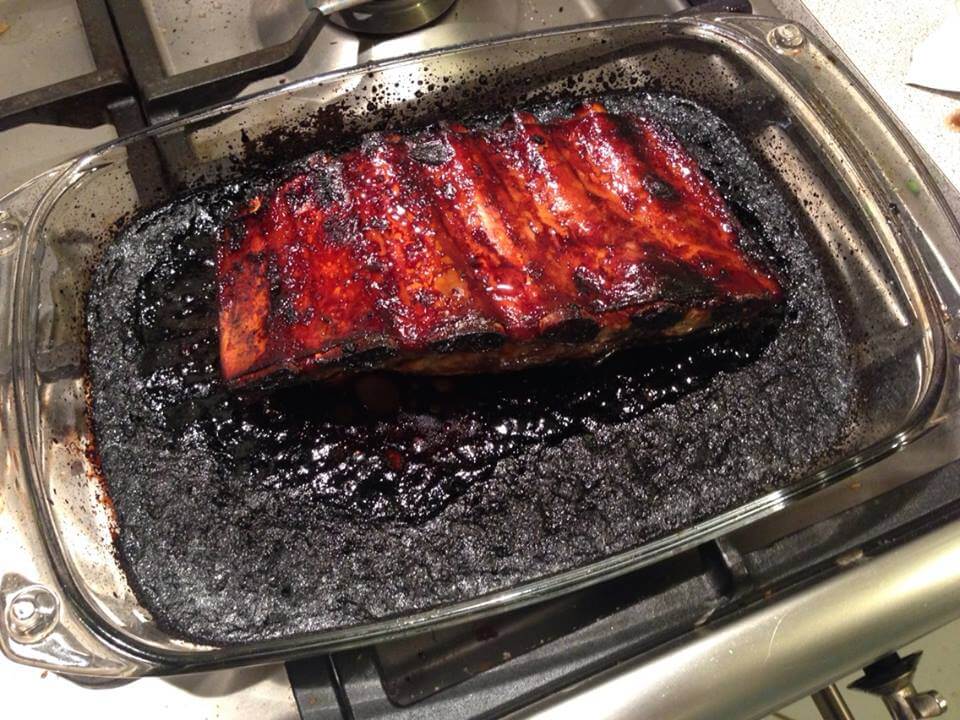
I love cooking (despite the occasional burnt offering) but a major part of any travel adventure is eating wonderful foods I haven’t cooked myself.
The advent of celebrity chefs and food and travel blogs, the proliferation of cooking shows and the Food Network (not to mention the stupendous late Anthony Bourdain, who turned food and travel into a passion for many of us) ― all these help promote the discovery of new foods, making culinary vacations more popular than ever.
The Food Travel Monitor (a global study by the World Food Travel Association) says an unbelievable 95% of American travelers are interested “in some kind of unique food experience“. I can only believe that these food tourism statistics are at least that high for travelers from other countries.
The search is on for new experiences, especially for something that tastes like a true slice of local culture. And what can be closer to a culture than the way it eats? A foodie trip is cultural travel at its best.
So… is Chinese food in Shanghai the same as you know it at home? Is your ‘authentic’ Thai corner eatery really authentic? Your food holidays should have the answer.
Culinary tourism definition – or what is food tourism?
“Culinary Tourism includes culinary experiences of all kinds. It’s much more than dining guides and restaurant weeks. It encompasses cooking schools, cookbook and kitchen gadget stores, culinary tours and tour leaders, culinary media and guidebooks, caterers, wineries, breweries, distilleries, food growers and manufacturers, culinary attractions and more. Authenticity is also of critical importance to culinary tourists.”
– International Culinary Tourism Association
…”a trip to a gastronomic region, for recreational or entertainment purposes, which include visits to primary and secondary producers of food, gastronomic festivals, food fairs, events, farmers’ markets, cooking shows and demonstrations, tastings of quality food products or any tourism activity related to food.”
– World Tourism Organization
TOURISM AND GASTRONOMY, AND WHY ONE IS SO IMPORTANT TO THE OTHER
The more we travel, the more sophisticated we become ― and the more we need to experience a destination rather than simply see it. Gastronomic travel provides a perfect window for that experience.
Even if gastronomy isn’t the main reason for a trip, it often plays a key role. When you start plotting and planning what you’ll eat where, you are engaging in some sort of foodie or gastronomic travel.
Often, people interested in food and travel look for the best foodie destinations ― those with a reputation for good products, well prepared.
There are a growing number of culinary tourism destinations but I can’t list them all so… here are a few of my faves:
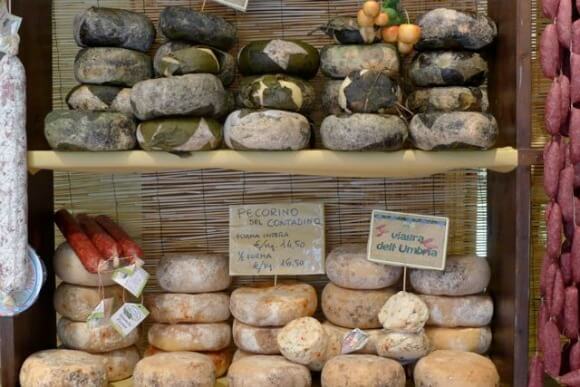
Italian cuisine: Whether for risotto or ossobucco from Milan, fegato from Venice, the pastas, the cheeses, the truffles, the vegetables, the oil, the fresh fish, the ice cream… oh, the gelato!
And shop after shop of hanging sausages, stacked cheeses and other delicious products.
While most people go to Milan for the fashion, I go for risotto and to stock up on carnaroli rice (like arborio only creamier), good pasta, olive oil and bottles of Crodino for the winter.
Risotto is a rice dish that is anything but light, so it’s more of a fall or winter comfort food. This is partly because of the natural creaminess of the rice, of course, but also because of the butter and cheese that are liberally mixed into it.

Cooking from Provence, which locals call the cuisine du soleil et du coeur ― cuisine of the sun and heart. It is sun-drenched and bursting with freshness, from the well-seasoned bouillabaisse fish soup to the simple ratatouille (the best result is achieved by cooking each vegetable separately). Good French cooking (and yes, there is most certainly such a thing as bad French food) is among the most sublime on earth. Above is one of my favorites: fruits confits, or candied fruit.
Speaking of French food, many people make a face when I mention Lyon’s frogs’ legs and escargots. They require slightly cooler weather and come fall, I hop on the train for an hour to visit my favorite food mall in France, the Halles Paul Bocuse.

New York’s diverse heritage makes it a food mecca, with successive waves of immigrants contributing their cuisine to the mix, from foot-high pastrami sandwiches to lox and bagels (although Montreal gives it a run for its money on smoked meat and bagels!) New York has wonderful, healthy and varied foods ― but once in a while, when I need comfort food, this is what I get.

Middle Eastern food is hugely popular, whether from Lebanon, Egypt or Turkey. Greece isn’t far from that neighborhood either ― from mezze, those bite-sized starters, to the grills and fresh vegetables and cumin-flavored delights of any good table, all rounded off with baklava or similarly addictive pastries.
And let’s not forget stuffed vine leaves, tabouleh, hummus, babaghanoush, feta… When traveling through the Middle East I inevitably gain weight ― I don’t know what to eat, or what not to eat, so I eat it all.
I love Turkish food under any circumstance; like baklava, for instance – that feathery pastry gooey with honey, filled to the brim with chopped walnuts or pistachios. It is often sold by the tray load in pastry shops but when you go for coffee, you can order a single one – and one will be more than enough. Or these sweet round pastries whose name I don’t know – they look like churros but are drenched in honey!
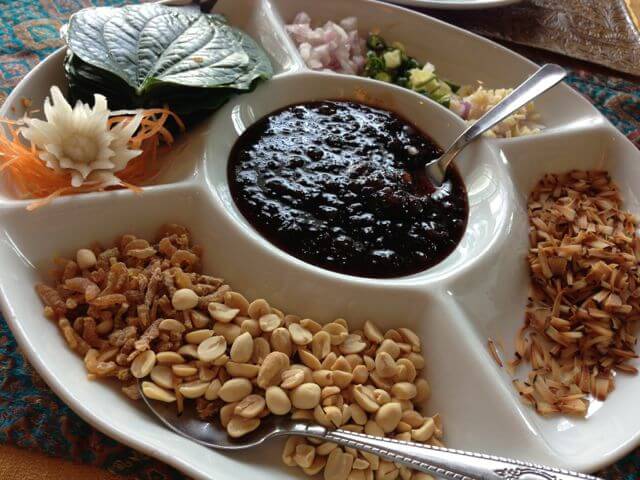
To me, spicy food means Thailand, where I lived for two years. The more I ate it the spicier I liked it. Thai food is incredibly rich and textured, with tastes ranging from sweet to salty to sour to spicy all in a single bite. Much of this comes from the influence of neighbors like Burma, Malaysia, and China.
Miangkham, a traditionally pre-prepared Thai delicacy sold on the street, is also a staple of good restaurants now. But in Thailand, street food still reigns!
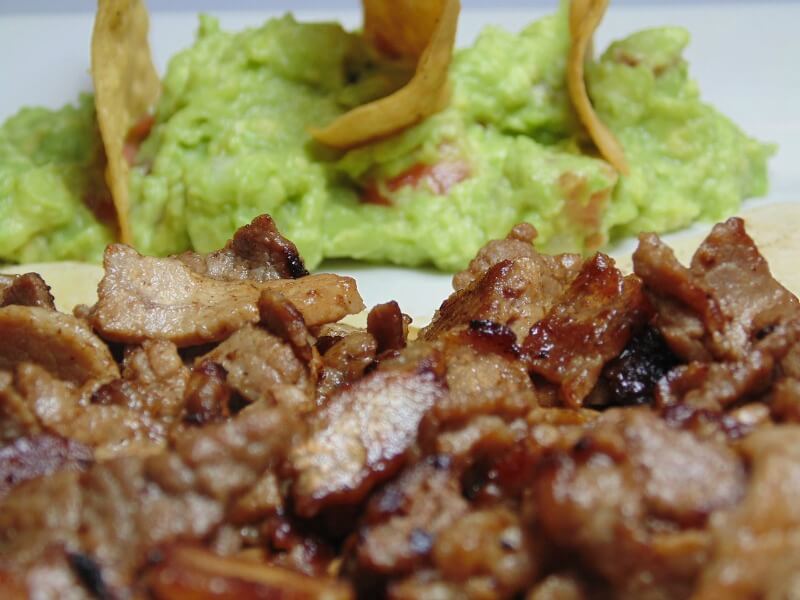
For foodie tourism with heat, those of you with a robust palate should head to Mexico for chocolate-based mole sauce and ceviche, of course, but also for more unusual fare. In Oaxaca, you can brave the chapulines ― deep-fried grasshoppers with garlic and lemon (I said you, not me!)
Mexico’s regions each have their own cuisines, from the northern meat-based meals to Yucatan’s spicier, more Caribbean-tasting dishes, but they never fail to impress me.

Sushi, sushi! I have had the fortune of spending a bit of time in Japan, long enough to sample Japanese cuisine at its most elemental. Japanese food exports well so chances are there’s an authentic sushi or tempura or steak house near you but… you haven’t tried fresh sushi until you’ve bought it either at the fish market or in the basement of any major Japanese department store

Madrid’s mercados are as much about the eating experience as about the shopping. I try to visit Madrid each year and I go with an open mind, but as soon as I enter the Mercado San Miguel, there’s a jamón stall on the right that grabs me and simply won’t let me go.
The artists who slice this ham of hams do so by hand and manage to produce unbroken slices as thin as paper.
Tapas may well be my favorite type of meal – hop from bar to bar and munch along. Even paella comes tapas-sized!
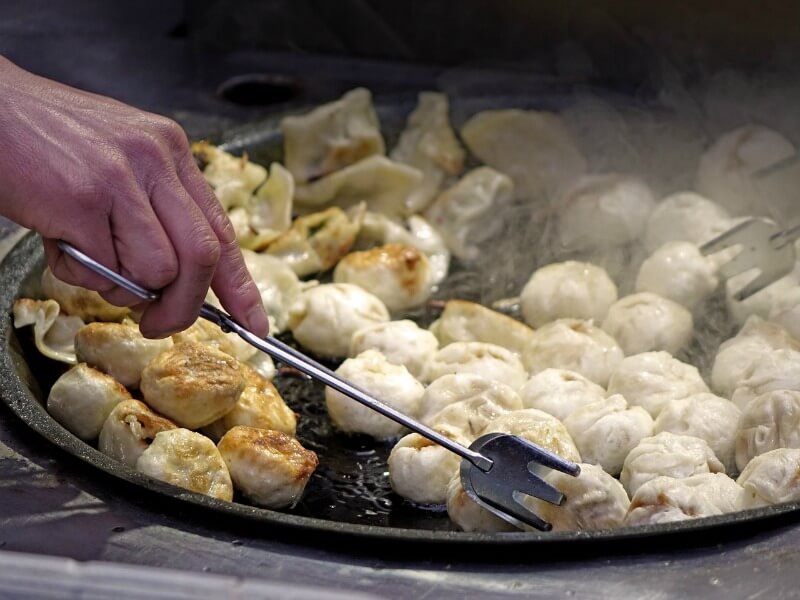
Of course, there’s extraordinary cuisine in many other countries: Peru is an acknowledged food tourism destination; Caribbean cuisine has a perkiness all its own; Brazil’s feijoada and Argentina’s steaks can be memorable; North Africa is the place for tagines, briks and couscous; and China has thousands of dishes you’ve never even heard of (except for the above dumplings ― which I’m sure you HAVE heard of).
BORROWED TRADITIONS: WHERE FOOD TRAVEL AND HISTORY CONVERGE
The Fascinating Story of the Indonesian Rijsttafel
The Indonesian rijsttafel isn’t Indonesian at all: it is a Dutch invention.
Indonesian food is involved, of course, but the construct is a product of colonial Holland, which ruled Indonesia – calling it the Dutch East Indies – for more than 350 years.
Because yes, initially the Dutch colonists avoided the sweet and pungent local dishes, preferring to import their own fruit trees and bushes and seeds and even livestock.
This was initially a male-only duty station of plantation managers and government administrators whose families stayed back home. Over time the men grew accustomed to the foods prepared by the single ladies who cared for their culinary – and other – needs.
But then something happened that would change food (not to mention world) history: the Suez Canal opened.
Once unable to undertake the lengthy journey and face the dangers of an unknown land, families began heading for the colonies and wives joined their husbands, bringing along their native foods and re-injecting these into local eating habits.
Many Dutch food imports were shipped in tins, with weeks of sultry unrefrigerated transport adding the threat of botulism to the then-blandness of northern European cuisine.
As did their husbands before them, the women began incorporating ingredients and techniques from both homespun and indigenous cuisines into their cooking, guided by their local cooks.
The result of this clash of culinary cultures was an Indo-Dutch medley that outstripped either of its component parts and may well be the world’s first fusion cuisine.
The Dutch loved it.
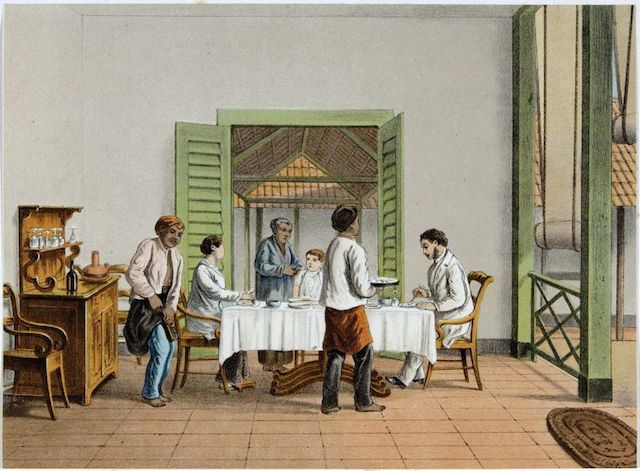
The Maluku Islands, part of the archipelago, had already given the world most of its nutmeg, cloves and black pepper. Indonesia had already hosted, willingly or not, immigrant waves of Chinese, Arabs, Indians and Portuguese, all of whom left their imprint on food. The inescapable diversity of the country’s own thousands of inhabited islands made sure ‘boring’ would never be used to describe the food.
Dishes from all these cultures found a home.
In a land of local poverty, the most vivid social demonstration of colonial power and omnipotence was a heaving, superbly garnished table – the rijsttafel, or rice table, mountains of rice surrounded by a multitude of small, delectable dishes. Of course it was also a great excuse for a party.
A traditional Indonesian rijsttafel
The rijsttafel was a formal affair with a Dutch family seated around a table. I can imagine their faces, red from the humidity, dripping with moisture. When a fly landed inopportunely, a sigh would rise and a languid arm, heavy with heat, would wave the intruder away. Local jongos, or male servants, would buzz about barefooted, carrying spicy dishes ranging from hot-hot sambal sauces to sweet and cloying peanut satehs. Just another day in the tropics.
The ‘feast’ usually included around 40 dishes. Some went beyond the call of duty. The famous French-run Hotel des Indes in Batavia, Jakarta’s colonial name, boasted as many as 60 different for Sunday lunch. Some private regal feasts could ring up 100 dishes or more, served ‘Dutch-style’, each dish on its own plate, and sometimes followed by steak, with the rijsttafel an immense appetizer.

On a recent trip to Amsterdam, I was asked what kind of Dutch food I wanted to taste.
I answered immediately: “Rijsttafel!”
Other than the barefoot waiters, it may not have changed much.
The table was already set with sambals, condiments and sauces when we arrived. Along came the rice – huge mounds of it – and the many courses, seemingly pell-mell, all deposited on a line of hot plates. Platters kept arriving and I stopped keeping track, but a few, apparently staples, were memorable.
The snacker in me dove for the crunchy, crispy prawn crackers, or kroepoek, so airy they stick to the roof of your mouth, and the sateh, that luscious spicy peanut sauce slathered over skewers of barbecued chicken, begging you to lick the plate clean (I withstood the temptation). My favorite was beef rendang, whose caramelized coconut sauce was an experience sensuous beyond taste.
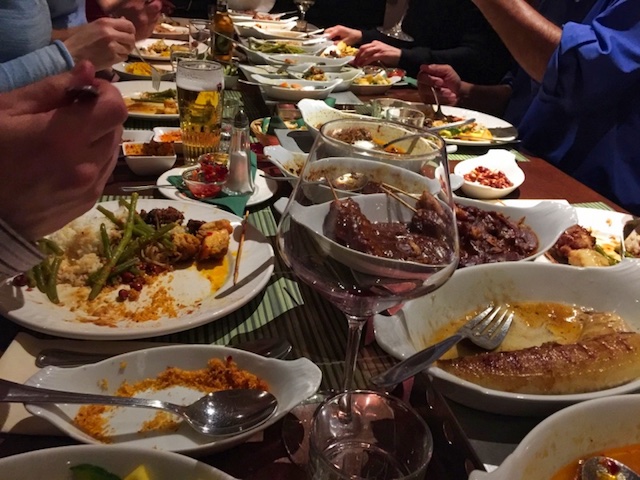
An unusual reverse migration was responsible for elevating rijsttafel‘s popularity in Holland.
As 19th-century transport links improved, Dutch tourists set sail for the colonies. They fell in love with the rijsttafel experience, food, waiters and all, and began taking the cuisine home with them. When colonial administrations rotated, recipes were brought back to Europe and handed down from mother to daughter, some closely guarded still today.
When the Dutch finally left Indonesia in 1949, the rijsttafel left with them, not only because the food was extraordinary but because, like most former colonial powers, a certain nostalgia set in. Subsequent waves of Indonesian immigrants cemented the fusion, sensing opportunity and opening the first rijsttafel restaurants in metropolitan Holland.
It may now be a favorite Dutch specialty but in Indonesia, resentment towards the former colonial power initially pushed locals away from this form of eating. Purely national ingredients and etiquette became symbols of independence and sovereignty. That resentment has eased and today this feast is found in many Indonesian tourist destinations.
It’s not uncommon for foreigners to look for an ‘authentic rijsttafel’ in Indonesia – whereas to get the real thing, they’d best travel back to Amsterdam.
CULINARY EXPERIENCES DON’T ONLY HAPPEN IN RESTAURANTS
One of the most common foodie finds will be a restaurant – big or small, modest or luxurious, street stall or in luxurious surroundings.
Whether you’re experiencing Noma for the first time (I haven’t yet) or chasing the best burger in the city, a sit-down meal is a central part of food tourism.
Central, yes, but not the only culinary tourism experience.
Eat with a local! The growing number of social dining networks make it easy to find a chef or cook who will host you for a meal at a reasonable price.
Another great experience is to dine with locals. Plenty of organizations are popping up in cities around the world to match up travelers with locals. EatWith, the world’s largest such network, has 25,000 hosts in more than 130 countries! Enjoy good company along with good food and gain a better understanding of your host culture.
Street food can be extraordinary. Food tourism in places like Thailand or Mexico means superlative street food ― I just find it more varied, tastier and fresher than anything you’ll find sitting down within four walls.
You can visit a market, many of which provide far more than produce. The Mercado San Miguel in Madrid, for example, is designed around an eating experience, not just shopping.
And while we’re on the subject of Spain, you can also eat in a bar ― that’s usually where you have tapas, just like in the UK you can eat in a pub.
One activity I enjoy when I travel is visiting a local supermarket. Foods are often different and I’ll get ideas ― and inspiration. Just step into a supermarket in Japan and you’ll immediately understand what I mean.
A small supermarket or grocery store is also the best place to grab some local cheese, cold cuts and spreads for that all-important picnic along the Seine in Paris…

TIPS FOR A GREAT FOOD TOURISM EXPERIENCE
With the growing popularity of food travel, be cautious about the quality of what you get. As with everything else, popularity may breed contempt.
Try to fit in one tour guided by a local. There are many wonderful tours and classes led by expats or long-term residents, but travel is also about coming into contact with the local culture so don’t let that dimension pass you by.
Don’t just be an onlooker. I’ve attended classes where one student stood at the front preparing everything while the others watched. You need to get your own hands wet and taste your own meal if you’re ever going to understand exactly what went into preparing it.
Try different courses. Some places are known for starters ― tapas and mezze for example ― while others are known for stews or desserts. Focus each meal on a different course.
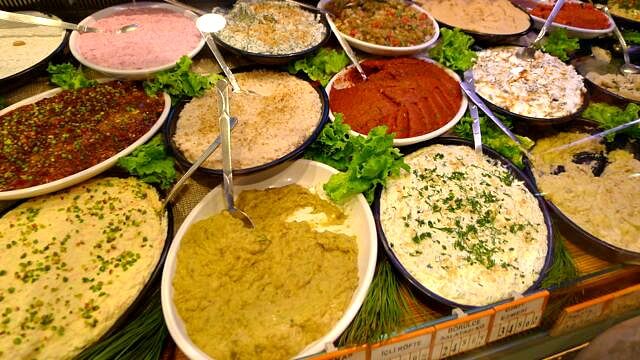
Avoid asking for ingredient changes unless you’re truly allergic or despise something ― especially in places where you know the chef pours her heart into her art. Each ingredient has its place and it’s the package that makes the experience a marvelously balanced one.
Reserve or at least call ahead, especially if you have your heart set on eating in a specific place. I’ve at times been disappointed to find a place full, closed or otherwise unavailable. Your hotel desk can make the call if you don’t speak the language!
Remember that food tourism includes drinks. Wine, of course, but I’m thinking chocolate con churros in Spain or Turkish coffee, as specialized as the food.
Check for cleanliness because standards differ. If things are a little messier than you’re used to, that doesn’t mean you’re facing a health emergency. Still, keep an eye on hygiene.
Don’t be afraid of street food. If it’s cooked freshly, cleanly, at high heat right in front of you, it will be as safe as anything else you eat, possibly even safer than hotel food that may have skipped a step in the cold chain.
Beware the much-translated menu. This isn’t always the case but I’ve found that a menu translated into a dozen languages screams ‘tourist trap’ and while I know they’re not all bad, I’d rather eat where mostly locals go.
Buy a local cookbook before you leave, along with a few special spices or condiments. Wrap these well in foil and plastic or your clothes may smell of coriander for weeks (and get the airport sniffy dogs all excited).
Look for variety in a food tour, course or experience. This Istanbul food tour had me sample more than two dozen dishes over two continents (and I loved it so much I retraced my steps on my own the next day). I also think you’d enjoy this Lisbon food tour. There are plenty of food tours in just about any city if you’re hungry, and I admit being guided around a city’s best foods is one of my favorite activities.
HOW DO YOU KNOW IF YOU’RE A FOOD TOURIST?
Well, let’s see… do you recognize yourself here?
- You’ll spend forever reading menus posted outside restaurants.
- Once you’ve read a menu, you’ll move on to the next. And the next. And then go around again.
- You’re the last person to order at a table and ask everyone else to go first ― you know, in case they order something even better than what you had in mind.
- When you finally do order, you’ll take forever because you’ll have questions. Many questions.
- When you’re planning a trip, you’ll look at restaurants before even thinking of hotels and flights. No review will remain unread.
- And when you’re finally reclining in that seat, your mind drifts to meals first, as you wave that airplane food away with your hand while composing the perfect menu in your mind…
I’VE BEEN ON A WORLD TOUR – NOW WHAT CAN I BRING HOME WITH ME?
Admit it. Each time you nibble that cheese in a French farmers’ market or let some prosciutto melt in your mouth, you’re really thinking: “I wish I could take some home with me!”
Sometimes you can.
Each country has its own list of what’s permissible, and some are surprisingly liberal.
The US, for example, seems to have radically liberalized its rules about what can come in and it allows all sorts of foods – cheese, cooked meats, spices, even fruit, which certainly wasn’t the case when Deputy Beagle barked at my illegal apple at Dulles Airport in Washington DC a few years ago and caused me great public embarrassment.
Here are some of key “I want to bring it home” listings for Australia (seems like the strictest), Canada, New Zealand, UK and USA.
FOOD TOURISM RESOURCES
- Here’s a list of great food bloggers to get you started (and I would add Food ‘N Road and Anita’s Feast)
- My favorite foodie read: Roads & Kingdoms, because it’s as much about the people as the food.
- In a completely different vein, I also enjoy Food and Travel Magazine.
- If you want to book a culinary vacation, this is the site for you.
- And here are some culinary tourism statistics (and food tourism trends).
— Originally published on 11 November 2011
SHOP THIS POST ON AMAZON
PIN THESE PICTURES AND SAVE FOR LATER!
